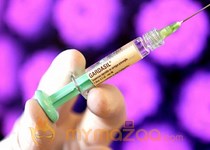Although human papillomavirus vaccination rates are relatively low in the US, this the first time a study has shown evidence of the effect on women in their 20s
Human papillomavirus (HPV) prevalence is down 64% since the Centers for Disease Control and Prevention (CDC) recommended a vaccination for the sexually transmitted infection a decade ago, according to a study released on Monday.
CDC researchers said this is also the first time a study has shown evidence of the effect of the vaccination on women in their 20s, where prevalence decreased 34%, even though vaccination rates for HPV are relatively low in the US.
The US government study, published in the journal Pediatrics on Monday, built on data from 2013 that showed a significant drop in HPV prevalence among teenagers since the vaccination was recommended in 2006.
Lead author Dr Lauri E Markowitz said that prevalence should continue to drop as vaccine coverage increases. “And as women who got the vaccine when they were younger age move into these older age groups, we should continue to see a continued decrease,” she said.
HPV is the most common sexually transmitted infection in the US and about 79 million Americans currently have the infection, according to the CDC.
To show the change between the “pre-vaccination era” and “vaccination era,” researchers compared the prevalence rates from 2003 to 2006 – the year the CDC recommended the vaccination for young women – to prevalence in the period from 2009 to 2012 – four years after the recommendation was issued.
For women ages 14 to 19 years, the rate dropped 64%. For women aged 20 to 24 years, the rate dropped 34%.
There are more than 40 different types of HPV, but subtypes 16 and 18 are responsible for most HPV-caused cancers. This quadrivalent vaccine referenced in the study targets subtype 16 and 18 as well as 6 and 11. Through 2014, more than 98% of people to receive the HPV vaccine were given the three dose quadrivalent vaccine.
“Overall, the fact that we are seeing a larger decrease overall than what we expect given our coverage rates does suggest there may be some herd protection and there also may be effectiveness from less than a complete three dose series,” Markowitz said.
HPV vaccine rates were hastened by stigma associated with the vaccine since it was recommended for girls aged 12 in 2006 – and then again when the CDC recommended it for young men in 2011. Parents were concerned that it encouraged sexual activity in young people, though studies show that is not the case.
Markowitz said: “We’re seeing impact of the vaccination program and that’s very encouraging and it shows how effective the campaign is but we can be even greater if we had higher coverage and we know HPV coverage lags behind other adolescent vaccines so if we had coverage higher we could see larger decreases.”












